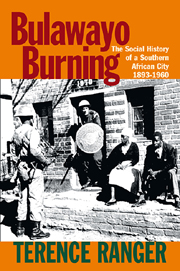Book contents
- Frontmatter
- Contents
- List of Illustrations
- Introduction
- Prelude: Bulawayo, 1893–1930
- 1 The Landscapes of Bulawayo
- 2 The First Fires: December 1929
- 3 City versus State 1930–1946
- 4 Mr Black Bulawayo 1930–1948
- 5 The Feminization of Black Bulawayo 1948–1960
- 6 Black Bulawayo Transformed
- 7 Black Bulawayo Burns 1960
- Postlude: Bulawayo after 1960
- Selected Bibliography
- Index
3 - City versus State 1930–1946
Published online by Cambridge University Press: 05 April 2013
- Frontmatter
- Contents
- List of Illustrations
- Introduction
- Prelude: Bulawayo, 1893–1930
- 1 The Landscapes of Bulawayo
- 2 The First Fires: December 1929
- 3 City versus State 1930–1946
- 4 Mr Black Bulawayo 1930–1948
- 5 The Feminization of Black Bulawayo 1948–1960
- 6 Black Bulawayo Transformed
- 7 Black Bulawayo Burns 1960
- Postlude: Bulawayo after 1960
- Selected Bibliography
- Index
Summary
The Intervention of Howard Moffat
White Bulawayans had been supportive of Responsible Self-Government in the 1923 Referendum, but they were determined not to allow their elected government too much power. The town was the centre of white artisan militancy, and the white railway workers’ strike of 1929 threatened to bring down the government of Howard Moffat. Long thereafter Bulawayo constituencies provided the main support for the Rhodesian Labour parties. Moreover, the commercial elites who dominated the Municipal Council joined with white worker representatives in their suspicion of the effete, bureaucratic capital city, Salisbury. White Bulawayo was determined to do its own thing.
In particular, the Council was determined to run its African Location in its own way. The Location was the oldest in the country. The regulations which governed it had been drawn up in 1895 before any government regulations had been laid down. The Location was controlled by the Council's own police force. In Bulawayo in 1930 the railway administration controlled its own ‘native’ compounds; various employers housed African workers on their stands; and the Municipality ran the Location. The Rhodesian government had no direct authority over urban Africans and no responsibility for their housing or conditions.
And yet what happened in the Bulawayo Location affected the Rhodesian government. Lewis Gann remarks that at the end of the 1920s Howard Moffat, the Rhodesian premier, ‘for the first time found himself facing a small emergent “Africanist” movement’. The most articulate of these ‘Africanists’ lived in the Bulawayo Location.
- Type
- Chapter
- Information
- Bulawayo BurningThe Social History of a Southern African City, 1893–1960, pp. 107 - 130Publisher: Boydell & BrewerPrint publication year: 2010



